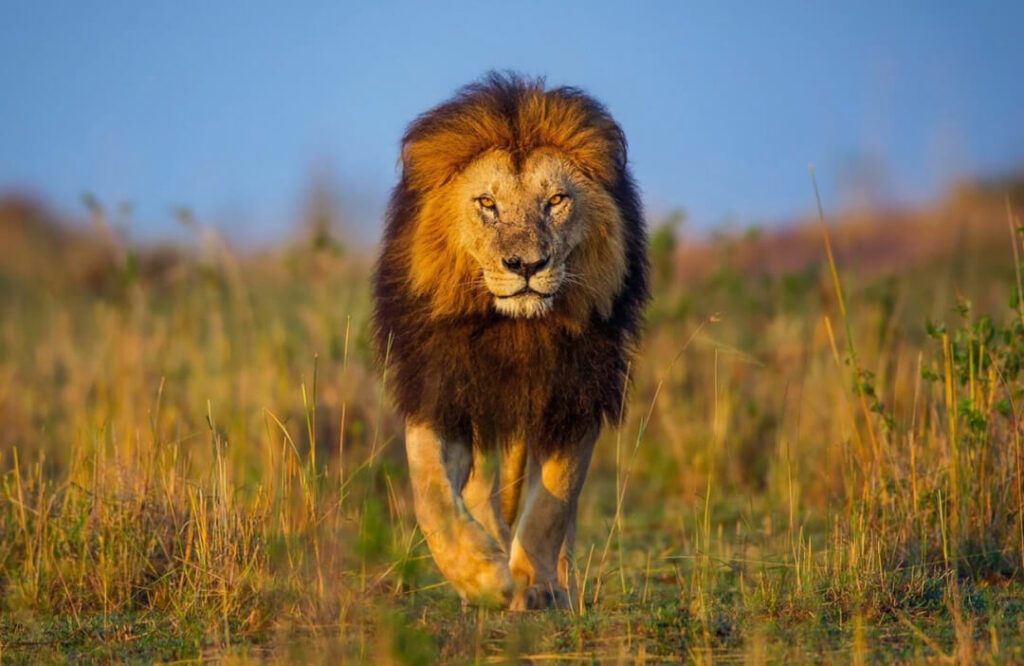Big game hunting in Africa is a bucket list item for many sport hunters: From the stunning hunting scenery to the thrill of the chase, safari hunting for African big game is an experience like no other. And apart from the countless photos and internalized memories, what other way could you best remember your hunting safari in Africa?
Trophies.
A big game hunting trophy may as well be a gold medal or prize certificate. It’s a physical reminder of the reward received in return for a hunter’s dedication, patience, skill, and effort. But how do you go about creating this trophy, and how do you ensure you’ll be able to bring it home to enjoy for years to come?
[DYNAMIC-BLOGTABLEOFCONTENT]
What is Taxidermy?
Taxidermy, in terms of its word origin, literally means “arrangement of skin.” It’s quite an appropriate meaning when considering the processes required to make a big game hunting trophy.
Taxidermy can is carried out on fish, reptiles, birds, and, of course, mammals that are considered African big game.
Common Taxidermy Methods
Not all of the following methods apply to big game hunting trophies, but it pays to have a broad understanding of the various methods used when looking into taxidermy practices and while game hunting in Africa, targeting your perfect species.
Skin Mount
In this process, an animal is skinned, and the skin will either be tanned or chemically treated. Next, the skin is placed over a mannequin figure; when completed, the taxidermist can use clay to help reform the facial features and attach the eyes for a more natural finish.
A traditional method for African big game hunting skin mounts is to keep the skull and front legs, if necessary, to assist in making the mannequin which could be created from plaster or wood wool. The final mold is usually polyurethane.
Freeze-Dried Mount
This process essentially mummifies the animal. All internal organs are removed, but the skeleton and musculature remain. The animal is posed and placed in a purpose-built freeze dryer where the vapor pressure is responsible for drying out the body. This process may not be for the African big game, but it’s one to keep in the back pocket for the smaller targets.
This process is used on smaller safari hunting animals like birds, snakes, and rodent species.
Reproduction Mount
A reproduction mount doesn’t require an animal at all. Instead, it uses photos and measurements so that a taxidermist can create a replica model, usually made from resin or fiberglass.
This method is popular with green rhino hunting practices and fishing enthusiasts who practice catch and release.
Recreation Mount
These mounts can be made from extinct or vulnerable safari hunting species and don’t require the species at all.
Instead, other natural materials replicate the animal’s coat, feathers, color, and skin. This method is common in museum displays and “mass-produced models.”
Types of Big Game Hunting Trophy Mounts
Displaying a trophy as evidence from your big game hunting in Africa is a surefire way of ensuring conversation starters and allowing you to relive the moment you took down a particular species during your African safari hunting adventure.
There are many different styles and ways of potentially displaying the trophy from your hunting safari in Africa, so let’s look into the most commonly available options for African big game trophies.
European Mount
This is also known as a skull mount and gets the name of European mount due to the story that protecting and caring for animal hides or trophies was expensive in Europe; hence this mount style makes use of the animal’s skull, jaw bones, and antlers in the case of antelope.
Mounted on a shield, these big game hunting trophies offer a traditional style and an almost old-world look. Traditionally, only the skull cap gets used, as well as the horns (if necessary). When the upper jaw is included it is known as a European bleach mount. In the case of carnivores, both jaws can be included, in either a closed or slightly parted position.
These mounts are relatively easy to care for as they only need to be dusted.
African big game suited to this style includes lion, leopard, sable, impala, kudu, and nyala, to name but a few.
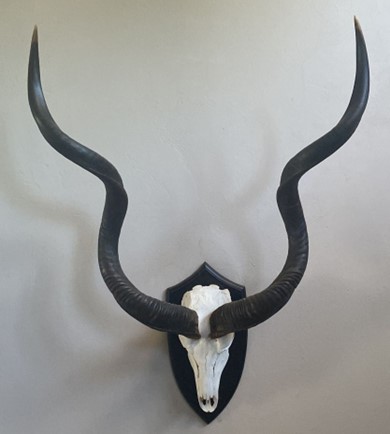
Shoulder Mount
One up on the European mount is the shoulder mount. These big game hunting trophies include the animal’s head, neck, shoulder, and partial sternum as well as skin up to the shoulder. They also make use of the skin or hide. Historically, these mounts were popular as they gave the most “natural” presentation of an animal.
A shoulder mount includes the proportionate features of the animal’s face, such as the eyes, nose, mouth shape, or expression. Features like the cheek or other facial ridges are constructed using clay, giving the best possible look. This type of mount is a great middle ground between a European and full–body mount as it gives the most natural and life–like look without compromising too much on space or budget.
Shoulder mounts are used for the plains side of game hunting safaris in Africa and include animals such as the waterbuck, wildebeest, impala, kudu, lechwe, and gemsbuck (oryx).
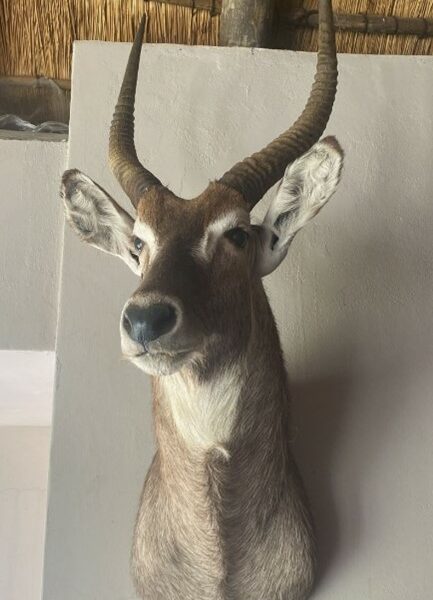
Full-Body Mount
The grandest and most expensive of mounts, the full-body mount, is the most impressive and lifelike way of bringing home your trophy after big game hunting in Africa. The animal’s entire skin gets used, and the trophy is posed naturally and dynamically. Full-body mounts can include the trophy on a plain base or one depicting the animals’ natural habitat.
These trophies best lend themselves to the African big game predators, such as the lion, leopard, and crocodile.
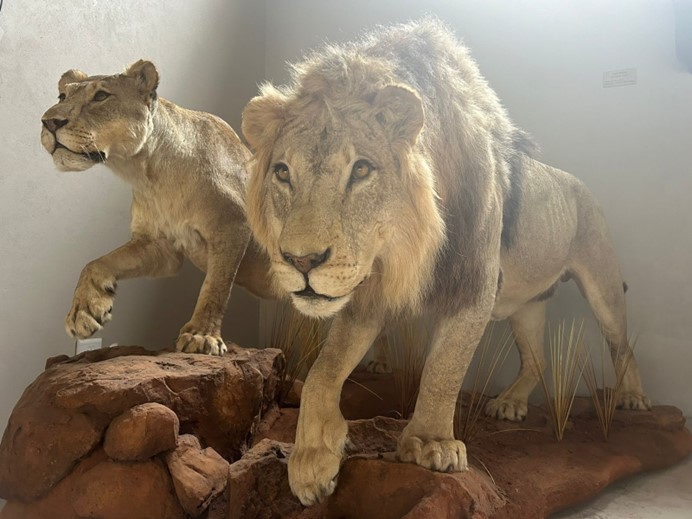
Pedestal Mount
This mount style features the animal’s front portion or front half that gets mounted onto a pedestal base traditionally made from teak wood. This mount can be a great alternative to a full-body mount as it provides the same 3D, free-standing appeal, but at a lesser cost. The pedestal can also be completed to depict the animal’s natural habitat.
Big game hunting trophies best suited to this mount are usually the plains species like kudu, gemsbuck, and wildebeest, but also used for crocodile trophies, where the animal gets mounted in a leaping motion.
Pedestal Wall Mount
The pedestal wall mount features a curved backing to ensure that even with the trophy mounted on a wall, the viewer can get a full-dimensional look and side view of the trophy.
Rug Mount
Keep your African big game hunting trophy close and underfoot with this mounting style! A near staple of any movie villain’s fireplace area, the trophy rug mount is one way to ensure the full display of the hide without worrying about additional space. Rug mounts also offer the most display versatility in your home, as they can be used with the existing furnishings.
A rug mount is a great value add–on to a wall mount as you will be using all the skin and can enjoy both the hide and front look of your trophy.
Trophies from hunting safaris in Africa that suit this mount type include various antelope such as the Oryx, springbok, and nyala (particularly when paired with a wall or pedestal mount) and zebra. Antelope rug mounts do not feature the horns.
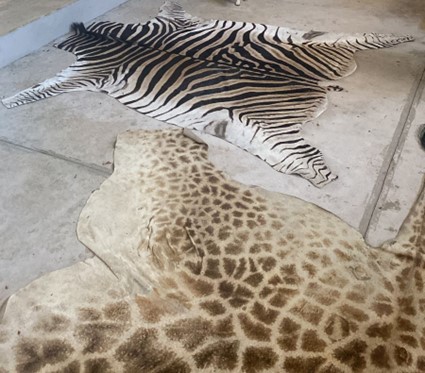
Head–On Rug Mount
Similar to the above, a head-on mount includes the trophy’s head (with artificial teeth) in a forward-facing placement to ensure maximum impact and hide use.
African big game species that work well with this mount style are the lion, leopard, cheetah, and Nile crocodile.
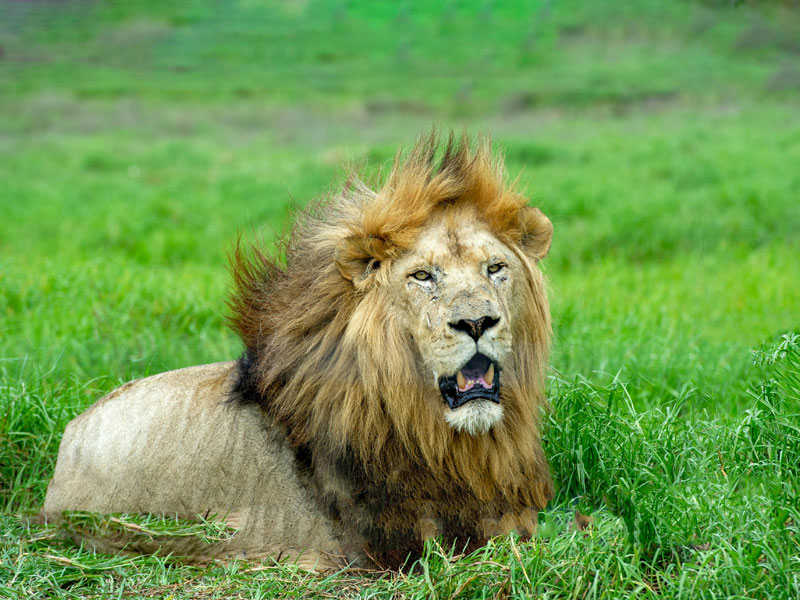
Big Game Hunting Trophy Processes and Responsibilities
Export broker
The export broker is arguably the most important person in the trophy exportation process. Their responsibilities include checking that a safari hunting trophy’s permit and tag numbers match, in addition to those of the import and export permits. They also check the permit for notes relating to quota and ensure this matches the hunt period given on the export permit. Once they have completed these checks, the permit must be checked by Customs and CITES (if necessary) for it to be stamped and signed, rendering it valid.
Import Broker
The import broker deals with port and customs authorities and the United States Fish and Wildlife Service (USFWS). If they can see the import/export permits before the shipment leaves, they can check for and correct errors that may affect the transport or release of the trophy.
Hunting Operator
Your operator is the initiator of the export process. By using their knowledge and relationships with taxidermists and export brokers, your operator should be able to give the best start possible to the exportation process.
Taxidermist
The taxidermist’s responsibilities include the correct tagging and identification of the trophy. These tags and identification information must match that of the export permit, and due to the close contact between the taxidermist and trophy, they are most likely to ensure that this information is correct. It helps that often the taxidermist is responsible for acquiring the export permit.
Exporting Your African Big Game: Permits and Regulations
Big game hunting in Africa is strongly regulated by the government or those managing the land on which the hunting safari takes place. Exporting of African big game trophies is just as regulated, and the species in question can impact the necessary documentation required for the export process.
The following best explains the requirements and needs of the trophy export process when getting your big game hunting trophies home after a hunting safari in Africa.
Documents for Exporting African Big Game
- First and foremost, you must ensure that all details and documents are completed correctly, with the correct information.
- Ensure that you have copies of your hunting license and hunting register. These documents will include the species information such as measurements, gender, as well as and the area in which it was hunted. The documents need to be signed by you, the PH, the landowner, the outfitter, and the game scout (if you have one). If you hunted on different lands or had different PHs during your hunts, you must keep an accurate record of this information.
- In government-controlled areas, the game scouts’ records and a copy of your hunting license must be presented to the government’s wildlife office. The outfitter must then pay the Game Fee, after which a generic export permit will be issued, and the CITES permit if needed.
- Trophies need to be inspected by a government veterinary officer for clearance in the exporting country. Sometimes the officers also complete the import clearance paperwork.
- Animals listed under CITES 1 require both an import and export permit, and it is strongly recommended to apply for the import permit before the hunt commences. This import permit is renewable and will need to be renewed more than once during the export process.
- Animals listed under CITES II and III only need an export permit. This will be procured by the government of the relative country.
- All trophies entering the USA need their CITES tags from the hide used to make the game hunting trophy, and any skins imported must feature a locked CITES tag clipped through the skin. The information on this tag must match the information on the CITES document.
Raw Trophy Imports of Big Game Hunting Species
The import of “raw” trophies into the USA requires additional certifications and paperwork.
- Raw trophies have not been taxidermized and this relates to horns, skin, feathers, and bones that have just been dipped and packed.
- The US CDC requires permits for:
- Non–human primate materials
- Viverridae and rodent materials
- Primate bones and skulls
- These permits can be applied for by you, the taxidermist, or the shipping broker.
- All swine and ostrich trophies or materials require clearance by the United States Department of Agriculture Animal and Plant Health Inspection Service (USDA-APHIS).
- Ostrich products also require a separate VS-16-6 Import Permit.
Packing of Big Game Hunting Trophies for Export
- Never share a crate with other hunters for any reason. This can throw a major spanner in the works during arrivals.
- Wooden crates entering the US or Mexico must meet the standards of the International Standards for Phytosanitary Measures (ISPM) 15.
- Taxidermized trophies and raw materials must be packed separately.
- Before shipping your trophy, ensure that either you or your shipping agent have received all the required documents and CITES permits needed. It is advised that you retain the original CITES import permit to show USFWS on the arrival of your trophy.
- Ocean shipping can be used for taxidermized trophies while raw trophies are required to be air freighted.
- It is advised that you hire a customs broker and procure a Power of Attorney, as well as a Homeland Security Identity Verification for them to sign any declarations on your behalf.
- A trophy cannot be shipped until the country of import has received the correct flight documentation in the case of air freighting your trophy. 72 hours’ notice must be given before arrival to arrange for veterinary inspection.
Shipping Your Big Game Hunting Trophies by Sea
- Shipping by ocean may take longer, but it is the cheaper option.
- Firstly, inform your taxidermist if you’ll be shipping by ocean; this is so they can reinforce the mounting attachments and crates for sea shipping conditions.
- Apart from the above-mentioned paperwork and permits, you’ll also need to supply an Importer Security Filing 10+2.
- Charges that can be included when ocean freighting are port security, inspection charges, and terminal handling.
United States Clearance for Safari Hunting Trophies
- All game hunting trophy shipments must be handled by a USFWS-approved port of entry where they will be inspected by USFWS, US Public Health, or the CDC as needed.
- Once these checks are completed and approved, the documentation is handed to US Customs and Border Protection for the next steps.
- Before forwarding to customs, you need to ensure that all fees have been paid.
- At the time of import, you need to complete an Import Declaration for Wildlife (Form 3-177). This form is different from the standard Import Declaration.
Choosing a Service Provider for Your Big Game Hunting Trophy
Choosing the right taxidermist for immortalizing your memories of a game hunting safari in Africa can be daunting, especially if you’re a first-timer or want to get something different from previous trophies.
Having your African big game trophy taxidermized is a decision that requires some questions and a bit of research, but at the end of the day, a bit of extra effort can go a long way to ensuring you’re left with a quality big game hunting mount that meets your expectations.
Think About What’s Possible
By educating yourself on the potential mounts for a big game hunting trophy, you’ll have a basic understanding of ideas and mount considerations for each animal.
Do Your Research
Taxidermists often specialize in one practice or style of taxidermy over another, even if they can perform multiple mount styles.
If you’re looking for a specific mount type, it pays to choose someone who has the most practice and experience with that type of mount. The question of whether you’re mounting an African plains game antelope or an African big game species will also factor into the decision.
Keep Your Budget in Mind
As discussed earlier, some safari hunting mounts are more expensive than others and don’t forget that choosing someone more experienced or with specialist skills can push the price up a bit too (training and knowledge aren’t cheap!). Be upfront about your budget to see if any alterations or allowances can be made, particularly if you have your heart set on a specific mount. Your budget might weed out certain options, but it’s best to not run the risk of overspending when other fees are still pending. Having a hunting safari in Africa isn’t cheap, and neither is taxidermy, so be sure to plan long–term when considering your budget.
Contact Possible Taxidermists
Once you’ve done your research and decided on a budget, it’s time to contact potential service providers. Ask about their specialty and if you can see past work similar to what you’re wanting. Taxidermy isn’t cheap and you’ll want to make sure the person you choose can deliver on what you want.
Check Out Their Work
Once you’ve spoken with a service provider, see about contacting past customers or reading up on their reviews if they’re available. This can be helpful if you can speak with a past customer who had similar work done to what you’re after.
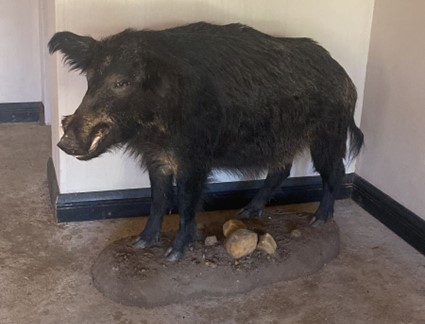
Time Required to Finish the Mount
Taxidermy isn’t a sprint, it’s a half marathon, particularly if you have detailed work done. This is a process that more than likely will take months, not days; and you’ll need to consider this if you have time constraints. It can also factor into the export process when procuring permits and shipping arrangements.
Take Your Time and Choose Wisely
Big game hunting in Africa is a wonderful opportunity, and by choosing to mount your trophy, you’ll have a permanent reminder of the time you gave an African hunt your best shot – and won. Big game hunting and taxidermy go hand in hand, and by making the right decision for your needs and your trophy, you’ll be ensuring a quality outcome for years to come.
Now that you know all the ins and outs of taxidermy for your big game hunting trophy, it’s time to plan your next African hunting adventure! Discover more about hunting in Africa and African game hunting safari destinations.
Author: A. Baker
